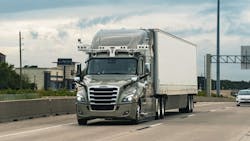Key takeaways:
- Autonomous vehicles are best viewed as transformative tools for freight that require focus on technology and operational challenges rather than as standalone businesses.
- Significant adoption of autonomous vehicles is occurring in ride-sharing, last-mile delivery, and hub-to-hub trucking due to the predictability offered by controlled environments.
- Transitioning to autonomous trucks requires a shift in management practices, emphasizing oversight of technology networks and addressing challenges such as fueling and customer service without human drivers.
PORTLAND, Maine—Self-driving trucks aren’t a business, they’re a tool—albeit a tool that will be “transformative” for the movement of freight. For fleets and the supply chain, the key will be understanding autonomous vehicles—the opportunities and challenges—and shaping operations strategically, or so a panel of entrepreneurs explained here at the recent WEX Venture Capital Summit: The Future of Fleet Investment.
Indeed, the rise of AVs is no longer a futuristic concept but a present reality, reshaping the landscape of fleet management. From Waymo's increased rides in San Francisco to police departments in Texas practicing how to stop an errant autonomous tractor-trailer, the integration of autonomy into daily operations is underway.
“Autonomous driving trucks is not autonomous trucking. Autonomous driving is a behavior. If I'm a driver, it's a job, it's an occupation, it's not a business,” Paul Lam, CFO for Houston-based Bot Auto, said. “Autonomous trucking is not only being driverless—it's being driverless, seamless, paperless, and, hopefully, relentless. So you're only doing a quarter of it.”
Bot Auto is a Level 4 autonomous trucking company focused on developing and operating its transportation-as-a-service autonomous truck fleet for freight customers. And, as Lam explained, operating an autonomous trucking business requires solving “10,000 different small problems” operationally to make the business model work.
“It's not just about the 1-to-1 [replacement of the driver] of the technology,” Lam said. “It's 1-to-1 of the product. Coming back to fleet management, it's figuring out the right business—to make a profit and to serve your customers.”
That technology piece, Lam was quick to note, is “really, really difficult,” but it’s been in development for quite some time and is finally viable. The next step is to solve the process now that the technology is available.
“You want to control and guarantee the outcome. And as we run our fleet, we have to think about several things, apart from the driverless technologies,” he continued. “Think about what a driver actually does when not driving: checking the tires, doing the paperwork, having coffee. How do we mimic that customer service, as we do not have a truck driver?”
As an example, he noted that Bot Auto’s trucks were often the last to be loaded or unloaded. “Why? Because we don't have a driver bringing coffee and donuts to the warehouse manager.”
Adoption drivers
Autonomy's most significant adoption has gained a foothold in three key areas: ride-sharing, last-mile delivery, and hub-to-hub (middle mile) trucking, noted Gagan Dhillon, CEO and co-founder of Synop, a software platform focused on supporting commercial EV fleets.
The primary reason for this concentrated adoption lies in the desire for controlled environments and predictability. Early successes are focused on highly controlled settings like ports, offering a clear understanding of vehicle duty cycles. Ride-sharing, for instance, builds upon existing concepts of automated people transport found in airports, now simply applied to a wider segment.
"You have a pretty good idea of what those vehicles are going to do on their duty cycle every single day," Dhillon said. “And there's a lot of data that you can gather from that and build out these autonomous systems—but also build out the infrastructure for what those autonomous systems need to operate.”
Likewise, with more than 2 million vehicles and 5.500 U.S. locations, Enterprise sees opportunities as the AV fleets evolve.
“We're not an OEM; we're not a tech company; we're not going to develop our own AV stack,” Mariano Menkes, Enterprise director of corporate development, said. “But when we think about the operations, we think that's a very important part of the value chain that we can play in.”
Operational hurdles
Beyond not having coffee and a chat with warehouse managers, AVs face other challenges due to not having a driver behind the wheel.
And this requires a paradigm shift in management. “This is a shift from managing drivers, which is what fleet managers spend all of their time on, to managing a network of computers,” suggested panel moderator Lee Carter, an investor with WEX Venture Capital.
It necessitates a "tech-enabled operation" rather than merely applying old methods to new assets, agreed Lam, who compared the change in thinking to the transition from horse-drawn carriages to automobiles.
“It should look different, and we have to embrace it,” Lam said. “If we were making the assumption that we have a disruptive technology here, and we can sell it as a toolbox or as a service to the existing value chain, too many miracles need to happen [to succeed]. In fact, we’d be lying in some way.”
Indeed, there is a critical disconnect between technology development and the practical realities of trucking operations, as Lam highlighted:
- Fueling and charging: For both diesel and electric AVs, figuring out how to fuel or charge without a driver at scale presents significant challenges, as there is no established playbook. Electrification, in particular, faces power constraints at large fleet depots.
- Maintenance and rescue costs: The absence of a driver makes pre-trip and post-trip inspection and maintenance akin to aviation standards. Rescue costs for stranded AVs are astronomical, often costing $4,000-$5,000 per incident, driving up total cost of ownership.
- Underwriting and insurance: As a new asset class, autonomous vehicles demand new risk models. The current high insurance costs in ride-hailing indicate a significant opportunity for refinement, as data demonstrates AVs are safer.
“Imagine if you're only selling the software, then you would not be able to guarantee the full process,” Lam said. “And, worse still, you are not able to make that operational trade-off versus the technologies because they are built in silos.”
See also: Trucking Tech Roundup: New announcements from DAT, Carrier Logistics, RaceTrac, Descartes
Opportunities and benefits
Despite the challenges, the opportunities presented by autonomous fleets are immense, the panelists agreed:
- Enhanced safety: Autonomous technology promises to drastically reduce accidents, especially those caused by human factors like fatigue or intoxication, leading to fewer massive payouts for insurance companies.
- Operational efficiencies: AVs enable improved scheduling, vehicle dispatching, and optimized energy management for electric fleets, which can have massive benefits for energy grids.
- Increased utilization: Technologies like AI and in-house calibration systems can significantly increase vehicle uptime, ensuring trucks and cars are on the road as much as possible.
- Economic resilience: At a macro level, autonomous trucking can bolster supply chain resilience, bringing manufacturing back and serving as the "backbone of the economy," leading to re-industrialization.
- Financial innovation: Particularly in middle-mile trucking, increased liquidity without human drivers will necessitate revisions to contracts, changes in risk and transfer points, and create new opportunities in areas like letters of credit and invoice factoring.
Impact on current models
The future of autonomous fleets is likely to see consolidation, with well-capitalized companies dominating because of their ability to scale and leverage data, concluded Menkes. Traditional automotive and fleet management companies, such as Enterprise, are keenly focused on the operational and asset ownership parts of the value chain. Their role will be as "enablers," providing existing infrastructure, branches, and large vehicle fleets as a "launching pad" for AV startups.
For freight fleets, the South and West will most quickly build out AV corridors—again, with the largest fleets taking the lion’s share of business because driverless operations won’t come cheap.
“When you think about other parts of the country, I think the smaller companies, smaller fleets, can still be very successful because those will take so much longer to automate,” Menkes said.
Likewise, early players in the AV space will come and go—but there's no going back.
"Almost every trucking OEM had an investment or JV into an autonomous fleet company at some point, and most of them have fizzled out," Gagan said. "I think there's a lot of learning that needed to happen, but the market's much more mature now for the leaders to revisit that model and that structure, and the next 12 months are going to show us that."
For trucking, reaching a "tipping point" means understanding that autonomy is a tool to reduce the total cost of ownership, deployed within a vertically integrated model to capture benefits that otherwise would be lost to poor operations or high communication costs.
“At the end of the day, don't try to reinvent the wheel. Worse still, do not try to feed customers something they didn't ask you for,” Lam said. “Fleet management is a very well-known concept. We can change it—not changing the terminology, but changing to the new way of next-gen fleet management—rather than trying to cookie-cut it and feed something into the existing value chain.”
About the Author
Kevin Jones
Editor
Kevin has served as editor-in-chief of Trailer/Body Builders magazine since 2017—just the third editor in the magazine’s 60 years. He is also editorial director for Endeavor Business Media’s Commercial Vehicle group, which includes FleetOwner, Bulk Transporter, Refrigerated Transporter, American Trucker, and Fleet Maintenance magazines and websites.
Working from Beaufort, S.C., Kevin has covered trucking and manufacturing for nearly 20 years. His writing and commentary about the trucking industry and, previously, business and government, has been recognized with numerous state, regional, and national journalism awards.


